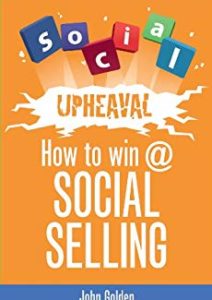Typing Too Much Is the New Talking Too Much
Stop Typing, Start Listening
One of the hardest lessons you, as the manager of a social sales team, will have to teach your salespeople (and perhaps even reteach yourself) is the seemingly dying art of listening. Why? Well because we have allowed ourselves to evolve into too much of a broadcast culture.
Social Media tools, while built around the concept of sharing and interacting, are all too often used for “push” communications both in business and in our personal lives. We have become seduced by the ease with which we can hit a few keys on our smartphone and in seconds broadcast an update, observation, or comment to the world at large. But how often do we really stop to read and absorb what others have written? Not as much as we broadcast, I would hazard. If we allow this to continue unchecked we run the risk of destroying all the great opportunities to learn that social platforms have given us.
Putting aside the larger question of human social evolution (or de-evolution depending on your viewpoint), the temptation to focus on the broadcast element of social selling is becoming ever more acute. Wherever you look these days it seems that a lot of sales experts are telling salespeople that they need to become prolific bloggers, serial posters, and incessant tweeters
This mantra of “blog, post, comment, like, share, tweet!” is sure starting to sound like a new incarnation of the old numbers game. Yes, it is almost like we are back to focusing on volume of activities, a place where a lot of sales managers actually feel quite comfortable. Think back through recent sales history and you will hear the echoes of the sales managers of yesteryear crying, “Send more emails!” “Make more calls!” “Mail more brochures!” “Knock on more doors!”
So as much as we like to think of ourselves as having become more sophisticated and more strategic in our approach, it is worth taking a step back and asking ourselves the question: Are we simply turning social media into another tool for volume-based activity? Is this spray and pray on steroids?
Teach Your Team to Resist Temptation
As a Sales Manager, you have a wonderful opportunity (indeed in many ways, a duty) to teach your salespeople that, although social media tools give them a vast array of ways to broadcast to a seemingly exponential audience of prospects, they need to resist that temptation and learn to listen first.
In other words you have got to tell them that just because they can, doesn’t mean they should. Ask them to block their ears to those who are seemingly instructing them to become one-person publishing houses, rest their fingers for a moment (Step away from the keyboard!) and learn how to adapt that most enduring skill of top performing salespeople — the ability to listen — to our increasingly complex online world.
There’s a Place for Publishing, Sharing, and Curation
Now let us offer a quick caveat here. We are not saying that publishing, sharing, and commenting on content does not have its place in today’s selling environment — because of course it does. What we are saying is that there are important steps to be taken before you dive in, and indeed you need to stay very clear and focused on your objectives once you do engage. This is important if you want to avoid falling into the activity-for-activity’s-sake circle of doom we described.
Simply put, you have likely coached many a rookie salesperson more than once about talking too much during conversations with a prospect. Well, typing too much is the new talking too much.
First Things First: Understand Your Target Buyer
The starting point for the remedy, however, is a little further back in the process. In our previous chapter we talked about aligning with the buyer’s journey. This chapter is very much a continuation of that idea. In order to understand your buyer’s needs, you must understand who your target buyer is. This is the best starting point in setting your salespeople up for being successful listeners online.
1. Buyer Personas are the foundation to social selling success
A bold statement for sure, but one we stand by.
Think about this — would be it more efficient and indeed strategic if, before your salespeople go onto LinkedIn, Twitter, or any other social platform looking for prospects, they had some clearly defined buyer personas that they could use to search against?
For those of you unfamiliar with the concept of buyer personas, they are actually pretty straightforward. Basically what you want to do is identify as many characteristics of your ideal buyer(s) as possible and build a profile that can then be used by both Sales and Marketing as a reference point for prospecting and marketing activities.
Buyer personas can include demographic information, be role and industry-specific, and have a particular set of common business needs. The more detail the better, as it helps you become laser focused — not only understanding who your target buyer is — but to guide opportunity selection and prioritization.
As a sales manager you should work with Marketing to define these personas and then spend some time going through them with your salespeople and showing them how they can use the characteristics of the persona to execute search strings and find look-alikes. For example, if a typical buyer or target buyer of your product is an HR manager who has been in their current role for 12 months or less in a small to mid-sized company (51-200 employees) in the Food Production industry, guess what? You have a pretty targeted persona to look for online. So spend time with your salespeople really getting to know your target buyer personas well as this will save a lot of time and wasted activity later.
2. When you find prospect personas online, Do Nothing!
Yes, this statement is a little facetious — but once your salespeople find their target buyers online you have to make sure that they don’t dive in and pitch to them.
Perhaps you have experienced as many Direct Messages on Twitter or InMails in LinkedIn as we have — where a salesperson pitches a product without checking whether it is a fit, whether there is a need, whether I am even the right person in the company to pitch to, and so on and so forth. Doesn’t that just turn you off? And not only to the salesperson but also the company they represent? Don’t you say to yourself, what kind of sales manager is encouraging or allowing their salespeople to be so clumsy and poor in their sales efforts? I will wager you have, so your challenge is to make sure nobody is saying that about your salespeople!
Teach Thoughtful Listening — and Connecting the Dots
You need to teach your salespeople that when they locate their target buyer online, this provides a wonderful opportunity to listen. Your buyer is providing so many clues as to their needs, but only patience and diligence will reveal them.
As we all know there is a huge difference between hearing and listening, just as there is between reading and comprehending. Listening, just like comprehending, is a more intense, more focused, and ultimately more rewarding activity. In other words, your salespeople need to take time to study and understand what the buyer seems to be interested in. If they are blogging, read their blogs and dissect the content, if they share other people’s content, look for common threads, if they comment on other people’s content, determine what insights can be garnered from those comments. Encourage your salespeople to look for multiple data points and then become good at connecting the dots to create a composite view of each individual buyer.
3. Create an environment that celebrates research
It’s all very well to talk about your salespeople going online and researching and understanding target buyers, but quite another to create the environment where they are allowed the time and space to do so.
Show Your Team That You Embrace Social Selling Activities
It is, after all, counterintuitive (to most of us who have grown up in a sales culture that celebrates action) to see salespeople quietly navigating social media sites, reading, and absorbing what buyers are saying and doing. Our natural instinct is to consider this kind of activity as passive as opposed to sending emails, making calls or running off to meetings. Even in-person networking events appear on the surface to be more active.
It is up to you as a sales manager to change this way of thinking by making your sales team comfortable that you want them to become more informed sellers by researching their buyers. Naturally you need to make sure that the research they are doing online is efficient and productive, but isn’t that the same with any approach?
Set New Expectations for Ideal Daily Sales Activities
It is a good idea to have them set aside research time on their calendar on a daily basis — just like you have probably had them do for prospecting in the past. Then, during coaching and pipeline review sessions, go through their buyer research and ask them what have they learned that they can use to lay the groundwork for engagement with the prospective buyer. In essence — How is their research either qualifying in or out the prospect, and what are their plans to migrate them into a sales cycle?
By providing the space to do the research, and then reinforcing through coaching the need for online research to have a purpose and an outcome, you are steadily building a sales team that listens first, understands, validates, and then engages. Think of the difference that is likely to make to how today’s buyer perceives them and how it can differentiate them from the inelegant sellers who think that broadcasting voluminous content somehow makes them look smarter and better.
The reality has always been the opposite. The loud, fast-talking salesperson has always come second to the thoughtful salesperson who asks good questions, listens to the answers, validates those answers, and engages in a collaborative dialog.
Listening First + Engaging Thoughtfully = Sales Success
It’s no different online. Listen first, listen more, understand, reflect, and then engage. This is what you must teach your salespeople if you want them to be successful social sellers.













